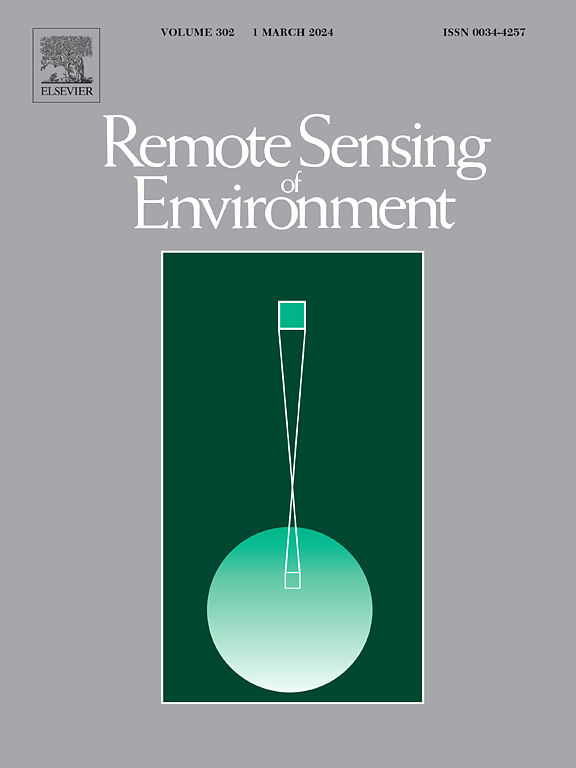Fine-scale poverty estimation by integrating SDGSAT-1 glimmer images and urban functional zoning data
IF 11.4
1区 地球科学
Q1 ENVIRONMENTAL SCIENCES
引用次数: 0
Abstract
Poverty is a pervasive global issue that adversely affects human well-being. Traditional socioeconomic censuses are time-consuming and resource-intensive, suffering from temporal delays, while reliance on nighttime light data with low spatial resolution is insufficient for fine-scale identification of impoverished regions. Furthermore, the spatial heterogeneity of nighttime light in different urban functional zones has been overlooked. To address these shortcomings, we proposed a novel approach by integrating high-resolution SDGSAT-1 nighttime light data (10 m) with urban functional zoning data using a spatial overlay tool. A random forest model was then applied to predict county-level poverty identification in Guangdong, China. For comparative validation, traditional NPP-VIIRS nighttime light data (500 m) were also incorporated. This method effectively explored the nonlinear relationship between nighttime light, urban functional zones, and the multidimensional poverty index (MPI, serving as the dependent variable). Our experiments demonstrate that the integration of urban functional zoning with nighttime light moderately improves the accuracy of poverty estimates. Among the models tested, the one considering functional zoning-based indicators of “number of light pixels” and “sum of pixel light values” increased the correlation coefficient by 0.0158 compared to the model without considering these indicators. Additionally, comparative analysis revealed that high-resolution data from SDGSAT-1 exhibited a better fit with the MPI when integrated with functional zoning-based indicators. Specifically, the correlation coefficient of this combination was 0.0086 higher than that of traditional NPP-VIIRS data. This highlights that SDGSAT-1 can delineate the boundaries between dark and light regions more precisely, leading to a more accurate reflection of regional poverty levels. Our findings facilitate fine-scale poverty estimation across large regions. This approach can inform policy design, such as dynamic optimization of resource allocation based on poverty estimates, thus enabling timely and accurate poverty alleviation efforts.
基于SDGSAT-1微光影像和城市功能区划数据的精细贫困估算
贫穷是一个普遍存在的全球性问题,对人类福祉产生不利影响。传统的社会经济普查耗时耗力,资源密集,存在时间延迟,而依赖低空间分辨率的夜间灯光数据不足以进行贫困地区的精细尺度识别。此外,城市不同功能区夜间灯光的空间异质性被忽视。为了解决这些不足,我们提出了一种新颖的方法,即使用空间覆盖工具将高分辨率SDGSAT-1夜间灯光数据(10米)与城市功能分区数据整合在一起。然后应用随机森林模型对广东省县级贫困识别进行预测。为了进行比较验证,还纳入了传统的NPP-VIIRS夜间灯光数据(500米)。该方法有效地探索了夜间灯光、城市功能区与多维贫困指数(MPI,因变量)之间的非线性关系。我们的实验表明,城市功能分区与夜间照明的整合适度提高了贫困估计的准确性。在被测试的模型中,考虑基于功能区划的“光照像素数”和“像素光照值总和”指标的模型比不考虑这些指标的模型的相关系数提高了0.0158。此外,对比分析显示,SDGSAT-1的高分辨率数据与基于功能区划的指标相结合时,更符合MPI。具体而言,该组合的相关系数比传统NPP-VIIRS数据高0.0086。这突出表明,SDGSAT-1可以更精确地划定暗区和亮区之间的界限,从而更准确地反映区域贫困水平。我们的研究结果有助于在大地区进行精细的贫困估计。这种方法可以为政策设计提供信息,例如根据贫困估计动态优化资源分配,从而能够及时准确地减轻贫困。
本文章由计算机程序翻译,如有差异,请以英文原文为准。
求助全文
约1分钟内获得全文
求助全文
来源期刊

Remote Sensing of Environment
环境科学-成像科学与照相技术
CiteScore
25.10
自引率
8.90%
发文量
455
审稿时长
53 days
期刊介绍:
Remote Sensing of Environment (RSE) serves the Earth observation community by disseminating results on the theory, science, applications, and technology that contribute to advancing the field of remote sensing. With a thoroughly interdisciplinary approach, RSE encompasses terrestrial, oceanic, and atmospheric sensing.
The journal emphasizes biophysical and quantitative approaches to remote sensing at local to global scales, covering a diverse range of applications and techniques.
RSE serves as a vital platform for the exchange of knowledge and advancements in the dynamic field of remote sensing.
 求助内容:
求助内容: 应助结果提醒方式:
应助结果提醒方式:


